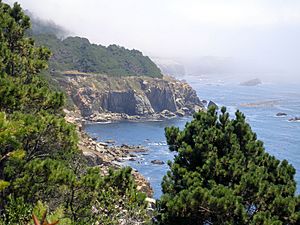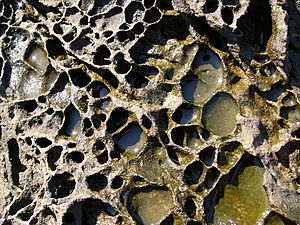Salt Point State Park facts for kids
Quick facts for kids Salt Point State Park |
|
|---|---|

Gerstle Cove
|
|
| Lua error in Module:Location_map at line 420: attempt to index field 'wikibase' (a nil value). | |
| Location | Sonoma County, California, USA |
| Area | 6,000 acres (2,428 ha) |
| Governing body | California Department of Parks and Recreation |
Salt Point State Park is an amazing state park located in Sonoma County, California, United States. This park covers a huge area of about 6,000 acres (2,428 ha) right on the coast of Northern California. It has over 20 miles (32 km) of fun hiking trails and more than 6 miles (9.7 km) of rugged, rocky coastline. One special part is Salt Point itself, which sticks out into the Pacific Ocean.
Salt Point State Park is also home to California's very first underwater protected areas! The ocean waves are always crashing against the rocks, shaping them into cool and unique forms. These rocks continue underwater, creating many different homes for sea creatures. You can do lots of activities here, like hiking, camping, fishing, and scuba diving. Even in summer, the weather is often cool with fog and chilly winds.
The rocks at Salt Point are made of sedimentary sandstone. Because there's so much sandstone, you can find small, cave-like shapes called tafoni along the shore.
Contents
What's the History of Salt Point?
This park gets its name from the way salt crystals form in the cracks of the rocky coast. For many years, the native Kashaya Pomo people collected salt from this area. They used special tools made from abalone shells to scrape the salt off the rocks.
In 1853, two men named Samuel Duncan and Joshua Hendy built a sawmill on a hill above Salt Point. A few years later, they rented the land to a company from San Francisco. This company dug up the sandstone from the park. They used this sandstone to build streets and buildings in San Francisco, and even a naval base at Mare Island. If you look closely, you can still see drill holes in the sandstone at Gerstle Cove and on the flat land just north of it. In 1870, Duncan sold his land to Frederick Funcke and Lewis Gerstle. They shipped out 5,000 Cord (unit of volume)[convert: unknown unit] of wood every year and used most of the land for their cattle to graze.
Gerstle Cove: A Busy Port
At Gerstle Cove, you can still see the metal rings (called eyebolts) that were used to hold ships in place. This was a busy spot where sandstone and wood were loaded onto cargo ships. At first, they used wire cables attached to the cliffs to load the wood and stone. Later, two special chutes were built: the Miller chute and the Funcke & Co. chute. There was even a railroad pulled by horses that went from the Miller sawmills to where the boats were loaded. The sawmill could produce 18,000 board feet (42.48 m3) of wood every day!
Amazing Animals and Plants
Land Animals and Plants
The flat areas near the ocean, called marine terraces, are covered with brush and grasslands. As you go higher (about 100 to 300 feet (30 to 91 m) up), you'll find forests mostly made of Douglas fir trees. Even higher (around 300 to 500 feet (91 to 152 m)), there's a mix of trees like bishop pine and Douglas-fir, along with younger coast redwoods, madrones, and tanoaks.
At 1,000 feet (305 m), there's a big open grassland where animals like elk used to graze. There's also a special "pygmy forest" at about 550 feet (168 m) elevation. Here, you'll find tiny Mendocino cypress trees, bishop pines, and Arctostaphylos plants. These trees don't grow to their normal size because the soil is very acidic, doesn't have many nutrients, and has a hard layer close to the surface.
Many native animals live on the land, including black-tailed deer, raccoons, coyotes, bobcats, gray foxes, badgers, striped skunks, and lots of different rodents like squirrels, chipmunks, and field mouses. Sometimes, Bears and cougars visit the area, but visitors rarely see them.
The forests, grasslands, and ocean shore are home to a huge variety of birds. You might spot pelicans, ospreys, woodpeckers (including the big pileated woodpecker), and oystercatchers. Steller's jays and ravens are often seen around campsites looking for food!
Ocean Life
In April, you might not see much kelp, but it's already starting to grow. By August, the water is full of dark green seaweed. This seaweed provides a home for many different rockfish and other sea creatures. The coast of Sonoma County is famous for its slow-growing red abalone. It takes these abalone about 10 years to grow to 7 inches (180 mm) across!
Between December and April, you might be lucky enough to see gray whales migrating. They travel south to Baja California to have their babies.
Salt Point State Park is next to some special underwater protected areas: Stewarts Point State Marine Reserve & Stewarts Point State Marine Conservation Area, Salt Point State Marine Conservation Area, and Gerstle Cove State Marine Reserve. Just like parks on land, these marine protected areas help keep ocean wildlife and sea ecosystems safe and healthy.
How the Rocks Were Formed
The coast in this park is full of jagged rocks and steep cliffs overlooking the ocean. The constant crashing of the waves shapes and forms these rocks. When the tide is out, these rocks create many cool tide pools to explore.
Types of Rocks
The rocks at Salt Point are sedimentary rocks, mostly sandstone. All these rocks are tilted, which means you can see older layers of rock. The rocks at the north end of the park's coast are younger than the rocks at the southern end. Salt Point is named for the tafoni formations, which look like honeycomb patterns in the rocks. This happens when ocean water dries and salt crystals form in the cracks. These salt crystals interact with the sandstone, making some parts harder and other parts softer.
Deep-Sea Fans: A Look into the Past
The layers of sedimentary rock here show signs of something called a deep-sea fan. Imagine a very dense, muddy river flowing down a submarine canyon deep underwater. This super-dense water is called a turbidity current. Things like earthquakes or big storms can cause these underwater landslides. When this muddy water leaves the end of the canyon, it spreads out in a fan shape, like a fan you might use to cool yourself. The mud and sand layers get thinner the farther they are from the canyon.
All these layers of sedimentary rock were created thousands of feet below the ocean's surface. But now, you can see them above the water! This happened because the Pacific plate and the North American plate are slowly moving against each other. Since the oceanic plate is lower, it's being forced underneath the continental plate in a process called subduction. As the oceanic plate goes down, the continental plate scrapes off its top layers, slowly bringing them up to the surface over millions of years.
Fun Things to Do
There are so many fun things to do at Salt Point! You can go hiking, camping, fishing, exploring tide pools, picnicking, and scuba diving. The park has over 20 miles (32 km) of hiking trails and more than sixty campsites. The hiking trails go all through the 6,000-acre (2,428 ha) park, and many of them lead right to the beach.
Salt Point has only a few sandy beaches. Some of these beaches have picnic areas with benches and barbecues, perfect for a meal outdoors.
One of the coolest things about Salt Point is Gerstle Cove, which is one of California's first underwater parks! Gerstle Cove is a protected area, so no fishing is allowed there. Only small boats and scuba divers can enter Gerstle Cove. You can see a lot of the amazing sea life when the tide is out by exploring the tide pools. These tide pools are home to many different creatures, like sea anemones and starfish.
Fishing is allowed in most parts of the park, just not in Gerstle Cove. If you like to fish, you might catch fish like lingcod, cabezone, rockfish, and greenlings.
Activities You Can Enjoy
- Sea kayaking
- Bike trails
- En route campsites
- Environmental campsites
- Exhibits and programs
- Family campsites
- Fishing
- Group campsites
- Hike or bike campsites
- Hiking trails
- Horseback trails
- Scuba diving
- Wildlife viewing




